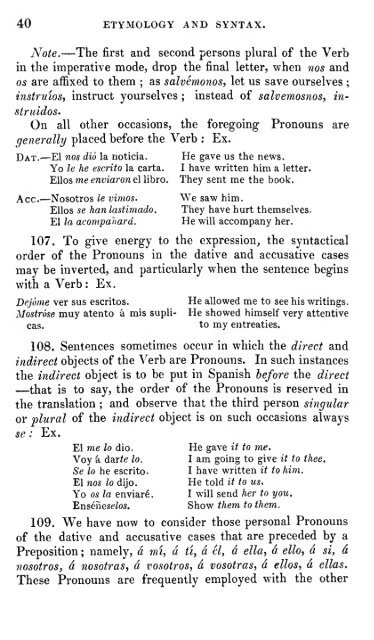A concise and simplified grammar of the Spanish language
A concise and simplified grammar of the Spanish language
A concise and simplified grammar of the Spanish language
You also want an ePaper? Increase the reach of your titles
YUMPU automatically turns print PDFs into web optimized ePapers that Google loves.
40 ETYMOLOGY AND SYNTAX.<br />
Note.—The first <strong>and</strong> second persons plural <strong>of</strong> <strong>the</strong> Verb<br />
m <strong>the</strong> imperative mode, drop <strong>the</strong> final letter, when nos <strong>and</strong><br />
OS are affixed to <strong>the</strong>m ; as salvémonos, let us save ourselves ;<br />
instruios, instruct yourselves ; instead <strong>of</strong> salvémosnos, in-<br />
struidos.<br />
On all o<strong>the</strong>r occasions, <strong>the</strong> foregoing<br />
Ex.<br />
Pronouns are<br />
generally placed before <strong>the</strong> Verb :<br />
Dat.—El nos dio la noticia. He gave us <strong>the</strong> news.<br />
Yo le he escrito la carta. I have written him a letter.<br />
Ellos me enviaron el libro. They sent me <strong>the</strong> book.<br />
Ace.<br />
—<br />
Nosotros le vimos. "We saw him.<br />
Ellos se han lastimado. They have hurt <strong>the</strong>mselves.<br />
El la acompañará. He will accompany her.<br />
107. To give energy to <strong>the</strong> expression, <strong>the</strong> syntactical<br />
order <strong>of</strong> <strong>the</strong> Pronouns in <strong>the</strong> dative <strong>and</strong> accusative cases<br />
may be inverted, <strong>and</strong> particularly when <strong>the</strong> sentence begins<br />
with a Verb: Ex.<br />
Dejóme ver sus escritos. He allowed me to see his writings.<br />
Mostróse muy atento á mis supli- He showed himself very attentive<br />
to my entreaties.<br />
cas.<br />
108. Sentences sometimes occur in which <strong>the</strong> direct <strong>and</strong><br />
indirect objects <strong>of</strong> <strong>the</strong> Verb are Pronouns. In such instances<br />
<strong>the</strong> indirect object is to be put in <strong>Spanish</strong> before <strong>the</strong> direct<br />
—that is to say, <strong>the</strong> order <strong>of</strong> <strong>the</strong> Pronouns is reserved in<br />
<strong>the</strong> translation ; <strong>and</strong> observe that <strong>the</strong> third person singular<br />
or plural <strong>of</strong> <strong>the</strong> indirect object is on such occasions always<br />
Ex.<br />
se :<br />
El me lo dio. He gave it to me.<br />
Voy á daríe lo. I am going to give it to <strong>the</strong>e.<br />
Se lo he escrito. I have written it to him.<br />
El nos lo dijo. He told it to us.<br />
Yo OS la enviaré. I will send her to you.<br />
Enséñeselo*. Show <strong>the</strong>m to <strong>the</strong>m.<br />
109. We have now to consider those personal Pronouns<br />
<strong>of</strong> <strong>the</strong> dative <strong>and</strong> accusative cases that are preceded by a<br />
Preposition; namely, á mí, a tí, á él, á ella, á ello, á si, á<br />
nosotros, á nosotras, á vosotros, á vosotras, á ellos, á ellas.<br />
These Pronouns are frequently employed with <strong>the</strong> o<strong>the</strong>r

















